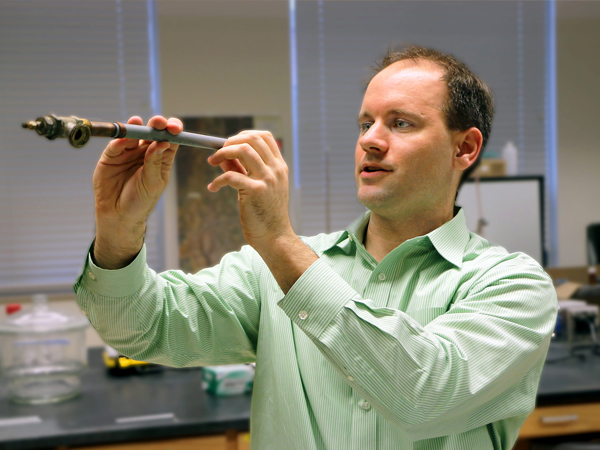Project focuses on reducing pathogen threat in low-flow water systems
Project focuses on reducing pathogen threat in low-flow water systems
| Author: | Emil Venere |
|---|---|
| Magazine Section: | Breaking News |
| Article Type: | Feature |
Low-flow building water systems designed to conserve water pose potential health hazards because they may cause an increase in disease-causing organisms and harmful chemicals.
A new Environmental Protection Agency (EPA) funded project led by Purdue University strives to help solve the problem.
“The increasing occurrence of low flows in water distribution systems and building plumbing presents an emerging health concern. Opportunistic pathogens more easily multiply under low-flow conditions,” said Andrew Whelton, an assistant professor of civil engineering and environmental and ecological engineering. “Building designers, managers and health officials need better information and models to predict health risks in plumbing systems found in all sorts of buildings, from schools to homes to health-care facilities.”
The organisms include the bacterium Legionella pneumophila, which causes Legionnaires’ disease; the brain-eating amoeba Naegleria fowleri; Pseudomonas aeruginosa, an antibiotic-resistant pathogen associated with serious illnesses; and Mycobacterium avium, which causes respiratory illness, especially in immunocompromised people.
“These opportunistic pathogens continue to cause waterborne disease outbreaks across the country,” Whelton said. “In fact, Legionella remains the most identifiable cause of waterborne disease in the United States.”
Purdue will work with researchers at Michigan State University and San José State University to better understand and predict water quality and health risks posed by declining water usage and low flows. The group is funded with a $2 million grant from the EPA. The three-year project, which begins January 2017, also will be funded with $1.1 million from non-federal sources, including Whirlpool Corp., Citizens Energy Group, and the Avon Community School Corporation.
“The research announced today will guide decision makers as they design, renovate, or manage plumbing systems to provide safe and clean drinking water,” said Thomas Burke, agency science adviser and deputy assistant administrator of EPA’s Office of Research and Development.

(Purdue University image/Erin Easterling)
Building plumbing in the United States has been trending toward low-flow rates to conserve water, going from 4 gallons per minute in 1994 to 0.5 gpm in today’s systems. However, while the flow rates have been reduced, the diameter of the plumbing pipes has not, causing water to age in the pipes.
“In low-flow systems, we have discovered that the water that reaches your faucet is going to be much older by the time it gets to you,” said Whelton, who described the problem during a recent conference, Dawn or Doom ’16, at Purdue. A video of the talk is available.
Whelton, the project’s principal investigator, will work with a team that includes Jade Mitchell, an assistant professor in MSU’s Department of Biosystems and Agricultural Engineering; Janice Beecher, director of the Institute of Public Utilities Policy Research & Education at MSU; Joan Rose, the Homer Nowlin Chair in Water Research at MSU and the 2016 Stockholm Water Prize Laureate; Pouyan Nejadhashemi, an associate professor at MSU’s Department of Biosystems and Agricultural Engineering; and Juneseok Lee, an associate professor and California Water Service Co. Chair Professor in San José State’s Department of Civil and Environmental Engineering.
“Lower usage and lower flows in water systems are raising engineering, economic, and public health issues, so an interdisciplinary approach is needed,” Beecher said. “This research is especially timely in terms of the urgency of optimal infrastructure investment with a focus on ensuring safe drinking water.”
The team will include Purdue doctoral student Maryam Salehi and Amisha Shah, an assistant professor of civil engineering and environmental and ecological engineering at Purdue.
“This project is innovative because it will enable a wide variety of stakeholders, who are represented by our comprehensive research partnerships, to prioritize sampling of existing buildings. We will also identify conditions to avoid during plumbing construction or to promote during renovation,” Whelton said. “The results will allow water utilities and government agencies to better predict changes in tap water quality based on distribution system water quality and operations.”
Whelton’s existing plumbing technology testing facility will be expanded at Purdue to examine plumbing component impacts on drinking water safety. His team has previously identified evidence-based methods to decontaminate chemically contaminated building plumbing. “We will develop the knowledge that identifies piping network design and operational conditions that can decrease microbial and chemical risks,” Whelton said. A Web-based “decision support system” also will be created. “Health risks in residential and commercial buildings caused by pathogen proliferation must be minimized through water infrastructure design, operation and maintenance decisions, and codes,” Whelton said.
The team will test hypotheses using various systems, including those in a residential home converted by experts from Purdue and Whirlpool Corp. into the most efficient domicile possible — a “net-zero” structure called the ReNEWW House; the National Conservancy’s Efroymson Conservation Center in Indianapolis, considered the most sustainable office building in the state; Avon Middle School North in Avon, Ind.; and two office buildings in Michigan.
“My colleagues and I designed the project to investigate drinking water quality where people live, where they work and where they send their kids to school. This was spurred by input we received from various stakeholders, including homeowners, parents and government officials who have contacted us in the past for assistance,” Whelton said.
The ReNEWW House has been equipped with energy- and water-saving features and solar panels that produce both electricity and hot water. “It is the perfect laboratory because we know all of the plumbing components, the flow rates and other system characteristics, and Whirlpool Corporation has been a tremendous partner.” Data from the research will be used to produce “predictive water quality premise plumbing models.”
“We designed our project based on drinking water safety concerns from the public, industry, and government agencies. Our approach harnesses world-class expertise from industry and other academics,” Whelton said. “We have an amazing team and are eager to start working more closely with our project collaborators and supporters.”